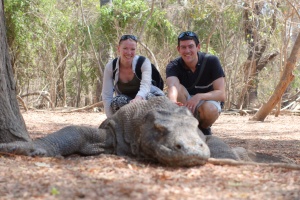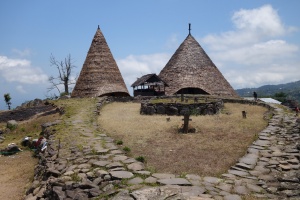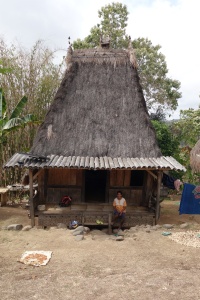We used Labaunbajo as our base to explore the Komodo National Park. On our second day we chartered a boat- through the most reputable company we could find- to go to Komodo Island. It was a 5am start followed by 4 hours each way on a boat called Armada, where both the vessel and the crew looked a little bit worse for wear. About 1 1/2 hours into the trip we were alarmed to see the crew bailing a large amount of water out of the boat and after hearing so many horror stories about boats sinking in Indonesia we were worried that the boat might be starting to sink. The crew didn’t really speak any English, but through hand signals we managed to establish that the boat wasn’t sinking and that there was an issue with the generator which pumps water out of the boat, which luckily they managed to fix.
We were very glad to set foot on dry land at Komodo Island, even if it was full of the largest and probably the most dangerous lizards on the planet! Komodo Dragons can be over 3m long and weigh 100kg. They have sharp teeth and extremely sharp claws, but it’s the potent bacteria in their mouths which enables them to kill prey as large as buffalo. Rangers take you around the island on foot to see these awesome creatures, armed only with a long wooden forked stick to protect you, if the Dragons were to attack. We went trekking for a couple of hours on the island (the first time we’d worn socks since Sydney) and were lucky to see 4 large Dragons, one baby Dragon (which are rare to see as they hide up trees for the first few years of their lives as larger Dragons are cannibalistic) and plenty of Timor Deer and Wild Boar. After trekking we did some snorkelling at the Pink Beach, where the sand is pink from the red corals and the fish are vibrant and plentiful.
Two days later we went out with a dive boat and did two dives around Komodo, which houses some of the best dive sites in the world due to the converging currents. The first dive was at Batu Balong, a pinnacle with a bountiful reef where we saw thousands of colorful fish, white tip sharks and octopuses. On our second dive we went to Manta Point. The diving was tough with strong currents, but the Manta Rays like the currents and we were lucky enough to see more than 10 Manta Rays on our dive. The Manta Rays were over 3m wide and it was an amazing experience to dive with them (and see them glide effortlessly through the strong currents). After our two dives we went trekking on Rinca Island where we saw another seven huge Komodo Dragons. That night we had dinner with Hannah and Matt (shout out guys!), a friendly American couple from Boston, who were in our dive group and are also on their travels. We randomly also bumped into them a few more times on our trip across Flores and they have been really helpful in our planning for Java since they have spent almost 3 months in Indonesia already.
From Labaunbajo, we started our journey across Flores, an island the Portuguese thought so beautiful, that they named it ‘flowers’. It is covered with towering volcanoes and lush forests of macadamia and mango trees, banana plants and bamboo. We took a bus to Ruteng, where we stayed in a convent with some friendly nuns. On our way out to explore the town we were greeted by a group of teenage boys who asked us where we were going and if they could follow us. Slightly unnerved we set off around town, quickly accumulating more followers on the way. We quickly discovered there was nothing sinister, but simply that they were students at a local tourism school who wanted to practice their English. We were out for about an hour and a half and by that time had spoken to over 60 boys who all wanted to ask us pretty much the same questions, get us to sign their autograph books and have their picture taken with us. We now know what it’s like to be a celebrity!
We explored the area around Ruteng by first taking a Bemo to Cancar (pronounced Chanchar). From there we walked to Cara Village where there was a viewpoint across the ‘Spiders Web’ rice paddies. Each segment of the web belongs to a different family and when a new generation is born a new section is added to the end. We met up with a Dutch couple that we had sat with at breakfast that morning, who were on a private tour and they offered to give us a lift to a road junction. Their guide was great, showing us wild clove trees and mimosas and helping us negotiate the next leg of our journey on a ‘Trek.’ A Trek is a wooden truck with a lorry cab at the front and planks of wood at the back as seats. We sat with about 20 locals- who seemed slightly amused that we were travelling with them- with bags of cement under our feet and had a very uncomfortable 2 hour journey down a single track, partially made road due to a road closure, (in most places the road was narrower than the vehicle!) followed by a short walk to the traditional village of Todo. The village was in a stunning spot and we had to wear traditional dress as we took a tour around the village. To get back to Ruteng our only transport option was to take Ojeks (motorbike taxis). This was Kate’s first ever trip on the back of a motorbike but the ride was fine, if a little bumpy. As this road is rarely frequented by Westerners, we were something of a novelty to the local people. Along the way many people stared, pointed, laughed, waved and all the children we saw would see us and smile and run out to shout ‘Hello’ and high five Alex as we drove passed. A few were a little cheeky and would shout ‘give me all your money’ and then laugh! Alex’s favourite person was an old man who looked like an Indonesian Andrew Sachs who when he saw us exclaimed ‘ooo Hello!’
From Ruteng we travelled to Bajawa where we found a local guide called Alfredo to take us to the traditional village of Belaragi. We took a car and then hiked steeply uphill to the village, where we were the only tourists and got to look around the village and meet the locals. We had lunch with Mama Mia (she hadn’t heard of Abba) and her family in her house which they prepared from the vegetables and rice we had got from the pasar (traditional market) earlier that morning. We took gifts of betel nut leaves and a few other offerings and the villagers all seemed very happy that we were visiting them. In the local Ngada language ‘hello’ is a high pitched ‘W-oo’ which the locals thought was hilarious when we tried to say it! On our way back we stopped off to see the local Arak distillery (two medium sized clay pots being heated outside a family’s house with long bamboo stems attached, which slowly dripped into plastic water bottles). We tried Arak Number 2 which is about 25% alcohol and had some fresh mangos from the tree. Arak number 1 is apparently 60% so we gave that one a miss!
We took a bus from Bajawa to Moni, on which we spent a lot of time talking to various locals using a mixture of our basic Bahasa, some of their basic English, but mostly elaborate sign language. The trip was extended to about 8 hours with the usual stops and detours- for picking up cargo, picking up people, stopping for passengers to buy things, stopping to have a chat, stopping for no apparent reason, etc.- being supplemented by a flat tyre which had to be changed and then when the spare tyre wasn’t any better, we had to visit the nearest ‘Docktor Ban’ (Tyre Doctor) where we waited for about an hour for them to prise the wheel out and get a new tyre fitted.
The tranquil highland village of Moni was our base for visiting Kelimutu, a mountain with breathtaking volcanic crater lakes (and breathtaking 650% price increases to enter the park as of 2nd September), which constantly change colour with the dissolving minerals. Often the three lakes are all different colours and locals believe that the spirits of the dead go there (young people to the vibrant turquoise lake, old people to the rusty coloured lake and bad people to the black lake). For our visit the second lake was also a deep turquoise but with rusty coloured water merging through. We were lucky enough to have the place to ourselves so we sat for over an hour watching the colours changing and taking in the spectacular views. We’d taken Ojeks about 16km up the mountain but decided to walk back down. We took a wrong turn which made our walk longer than it should’ve been and we both felt quite achy the next day. From Moni we took a bus to Maumere, a large town by the sea and from there we took a flight to Bali. We are now at Bali airport and it seems very foreign to be temporarily back in a ‘Western’ environment. From here we will fly to Surabaya for the start of our journey across Java.









Hi Alex and Kate, I am really enjoying your journey. I now need to look up where these places are but it really sounds exciting and interesting where you have been and what you have seen. I will share this with Jan too. Wishing a continued great journey, with love, Karen
LikeLike
Hi Karen,
Thanks for your message and great to hear from you. Glad you are enjoying the blog – all Kate’s hard work! It has been really great to experience such a variety of things so far – hopefully it will continue! Hope all is well with you and Jan. Love Alex and Kate x
LikeLike
Thanks for taking us on holiday with you. The commentary is really outstanding. Keeping travelling well. And keep the pictures coming. The one with the web agriculture is so interesting. Hugs Ian ans Shevani.
LikeLiked by 1 person
Thanks Shevani- we are having an amazing time! You are always welcome to come and join us if you fancy a holiday! Hope all is well with you and Ian, Kate and Alex xx
LikeLike
Hi you two. Glad you are having a fantastic journey, what you have seen and done so far is amazing. Just read all the blogs again and now feel quite exhausted!
How did you manage to miss any of the 2,000+ water temples on Bali?
Alex, after the Swansea result last week can you conjure up some Javanese magic for us against Man U next Saturday please?!!!
Happy travelling
Dennis. xx
LikeLike
Hi Dennis – Are there water temples on Bali!?! We ended up spending not too much time on Bali as there is so much of Indonesia to see in such a short space of time!
Glad you are enjoying the blogs – so sorry about Arsenal, hopefully things will get better soon. We’ve visited a few temples so maybe that will help!
Alex
LikeLike
Pingback: Mantas and Dragons |